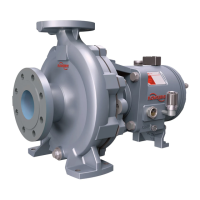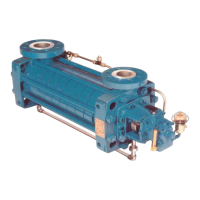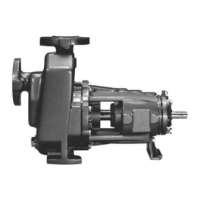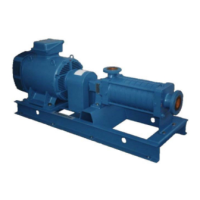DMX/DMXD/DMXH/DMXDDMX/DMXD/DMXH/DMXD
INSTRUCTIONS INSTRUCTIONS
Page 18 of 60Page 18 of 60
this may result in permanent deformation ofthis may result in permanent deformation of
Pump, driver auxiliary equipment andPump, driver auxiliary equipment and
piping shall be removed from the baseplate beforepiping shall be removed from the baseplate before
leveling the baseplate.leveling the baseplate.
Locate the baseplate in its proper position on theLocate the baseplate in its proper position on the
concrete block together with the leveling screws asconcrete block together with the leveling screws as
shown in the General Arrangement Drawing.shown in the General Arrangement Drawing.
Using a precision level across the machined surfacesUsing a precision level across the machined surfaces
of the pump and driver mounting pads, adjust levelingof the pump and driver mounting pads, adjust leveling
screws as necessary to ensure that baseplate isscrews as necessary to ensure that baseplate is
leveled in all directions.leveled in all directions.
When the baseplate is leveled, snug the foundationWhen the baseplate is leveled, snug the foundation
bolts, but do not completely tighten.bolts, but do not completely tighten.
Using the previous procedure, adjust baseplate untilUsing the previous procedure, adjust baseplate until
pump and driver are within 0.076 mm (0.003 in.).pump and driver are within 0.076 mm (0.003 in.).
The following information regardingThe following information regarding
grouting is only offered as a general guideline.grouting is only offered as a general guideline.
Flowserve requires that all grouting be installed inFlowserve requires that all grouting be installed in
accordance with specifications set forth in Chapter 5,accordance with specifications set forth in Chapter 5,
Mounting Plate GroutingMounting Plate Grouting
from API Recommendedfrom API Recommended
Practices 686/PIP REIE 686, First EditionPractices 686/PIP REIE 686, First Edition
API 610 - Eighth Edition - Appendix `L`API 610 - Eighth Edition - Appendix `L`
for baseplatefor baseplate
grouting requirements. It is recommended that thegrouting requirements. It is recommended that the
customer consult a competent specialist skilled in thecustomer consult a competent specialist skilled in the
field of grouting, to insure the proper installation of allfield of grouting, to insure the proper installation of all
The following ASTM Specifications are furnished asThe following ASTM Specifications are furnished as
references for test methods used in conjunction withreferences for test methods used in conjunction with
installation of grouting materials and should be usedinstallation of grouting materials and should be used
to obtain proper results:to obtain proper results:
ASTM C 78-84,ASTM C 78-84,
Test Method for Flexural Strength forTest Method for Flexural Strength for
ASTM C 109-90,ASTM C 109-90,
Test Method for CompressiveTest Method for Compressive
Strength of Hydraulic Cement Mortars – ModifiedStrength of Hydraulic Cement Mortars – Modified
ASTM C 469-87a,ASTM C 469-87a,
Test Method for Static Modulus ofTest Method for Static Modulus of
Elasticity and Poisson’s Ratio of Concrete inElasticity and Poisson’s Ratio of Concrete in
ASTM C 496-90,ASTM C 496-90,
Test Method for Splitting TensileTest Method for Splitting Tensile
Strength of Cylindrical Concrete SpecimensStrength of Cylindrical Concrete Specimens
ASTM C 531-85,ASTM C 531-85,
Test Method for Linear ShrinkageTest Method for Linear Shrinkage
and Coefficient of Thermal Expansion of Chemicaland Coefficient of Thermal Expansion of Chemical
Resistant Grouts and Monolithic Surfacing - ModifiedResistant Grouts and Monolithic Surfacing - Modified
ASTM C 666-90,ASTM C 666-90,
Test Method for Resistance ofTest Method for Resistance of
Concrete to Rapid Freezing and ThawingConcrete to Rapid Freezing and Thawing
ASTM C 939-87,ASTM C 939-87,
Test Method for Flow of Grout forTest Method for Flow of Grout for
Preplaced Aggregate Concrete (Flow Cone Method)Preplaced Aggregate Concrete (Flow Cone Method)
ASTM C 942-86,ASTM C 942-86,
Test Method for CompressiveTest Method for Compressive
Strength of Grouts for Preplaced Aggregate ConcreteStrength of Grouts for Preplaced Aggregate Concrete
in the Laboratoryin the Laboratory
ASTM C 1090-88,ASTM C 1090-88,
Test Method for MeasuringTest Method for Measuring
Changes in Height of Cylindrical Specimens fromChanges in Height of Cylindrical Specimens from
Hydraulic Cement GroutHydraulic Cement Grout
ASTM C 1107-91,ASTM C 1107-91,
Standard Specification forStandard Specification for
Packaged Hydraulic-Cement Grout (Non-Shrink)Packaged Hydraulic-Cement Grout (Non-Shrink)
(CRD-C 621-92), ACI 351,(CRD-C 621-92), ACI 351,
Grouting for Support ofGrouting for Support of
Equipment and MachineryEquipment and Machinery
24-Hour Test,24-Hour Test,
MBT Test Method for GroutMBT Test Method for Grout
Minimum requirements for epoxy groutMinimum requirements for epoxy grout
(typical properties at 23(typical properties at 23
Fire ResistantFire Resistant
Minimum Compressive Strength –Minimum Compressive Strength –
Height Change @ 38Height Change @ 38
Positive – Effective Bearing Area – 95%Positive – Effective Bearing Area – 95%
Maximum Creep in 1 Year –Maximum Creep in 1 Year –
in./in. at 140in./in. at 140
Minimum Tensile Strength – 12.4 MpaMinimum Tensile Strength – 12.4 Mpa
Minimum Flexural Strength – 26.2 MpaMinimum Flexural Strength – 26.2 Mpa
Minimum Flexural Secant Modulus –Minimum Flexural Secant Modulus –
Mpa (1.8X10Mpa (1.8X10
Maximum Coefficient of Expansion –Maximum Coefficient of Expansion –
Maximum Peak Exotherm 1000 gMaximum Peak Exotherm 1000 g
(35.27 oz.) insulated – 35(35.27 oz.) insulated – 35
F). Full AggregateF). Full Aggregate
Must Be Used.Must Be Used.

